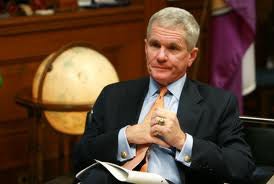 Clemson President Jim Barker, 65, said he felt like it was the right time to hand off leadership of the university to someone else.
Clemson President Jim Barker, 65, said he felt like it was the right time to hand off leadership of the university to someone else.COLUMBIA, S.C. — Clemson President Jim Barker is going back to being an architecture professor after 14 years leading the school.
Barker announced in a video message to students Tuesday that he will stay on as president until trustees pick his replacement, then go back to teaching.
Barker, 65, had emergency heart surgery in January to bypass five blockages, but said he is in good health and felt like it was the right time to hand off leadership of the university to someone else.
“I see this as a change in major for me, going from president to professor,” said Barker, who received his undergraduate degree in architecture from Clemson in 1970.
Barker became president in 1999 and worked to improve Clemson’s academics. The school says half of its 2009 freshman class graduated in the top 10 percent of their high school.
But some questioned some of Barker’s methods to improve Clemson’s standing in the U.S. News & World Report rankings. Barker once rated Clemson above every other school in the nation.
Barker gave his own university a “strong” rating in the peer review survey portion of the rankings but gave no other university that high a mark. He also ranked half the undergraduate universities in the magazine’s survey as “marginal.”
Barker also liked to back tangible ideas for his school. One of his biggest projects, Clemson’s International Center for Automotive Research, is designing the car of the future. The school’s latest project is a $100 million initiative to test power generating wind turbines in North Charleston. Clemson hopes the research will help South Carolina lead in what could be an emerging alternative power source.
Clemson came through the Great Recession in better financial shape, making Barker’s decision to step down easier.
“There’s never a perfect time for transition. But this is a good time because the university is in such good shape,” Barker said.
Barker told trustees about his plans to step aside last week. He said he promised to help Clemson’s 15th president make the transition into office.
Board of Trustees Chairman David Wilkins said Clemson is a far better place thanks to Barker’s leadership.
“We know that there is no replacing Jim Barker, only succeeding him,” said Wilkins, who was a fraternity buddy of Barker when they were students at Clemson.
Barker also was praised by Gov. Nikki Haley, a 1994 Clemson graduate who became the first governor to get her undergraduate degree from the school since Strom Thurmond.
“President Barker has given tremendous service to our state, he has been a transformative leader for Clemson, and he leaves the university better than he found it,” Haley’s spokesman Rob Godfrey said.
Barker also shaped the school’s athletics, resisting calls for the Tigers to move out of the Atlantic Coast Conference. He also backed major athletic expansions, even if the school’s teams did not reach his lofty goals when he came into office of a national championship in football, two Final Fours in basketball and two national championships in Olympic sports.
Barker ended his 2 1/2-minute speech with “Go Tigers!”


















